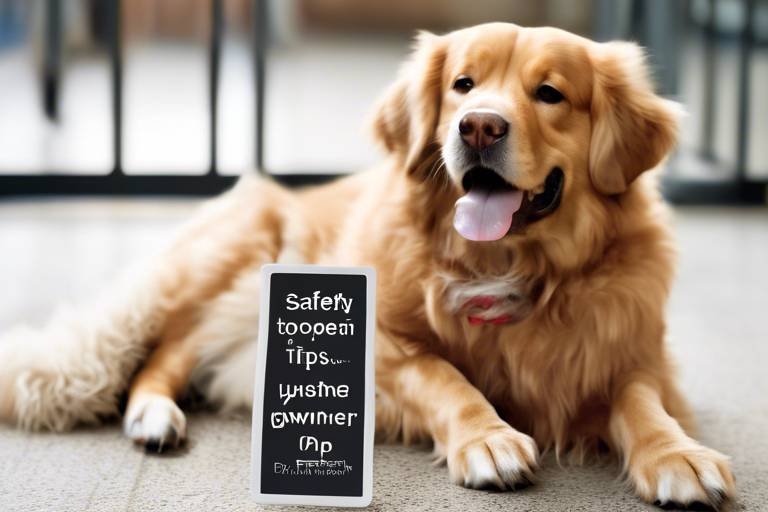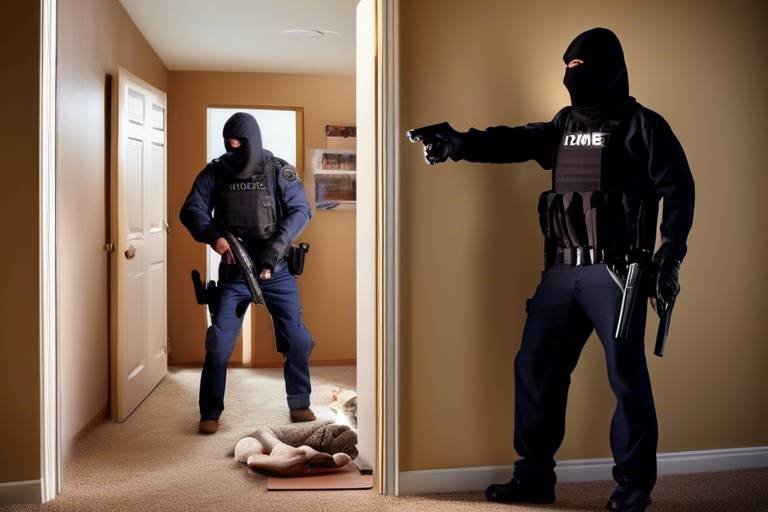Safety Tips for Pet Owners
As a pet owner, your furry friend depends on you for their safety and well-being. It's not just about feeding them and giving them love; it’s about creating an environment where they can thrive without any hazards lurking around. In this article, we will delve into essential safety tips that every pet owner should know. From ensuring your home is a safe haven to preparing for emergencies, we’ll cover everything you need to know to keep your pets safe and healthy.
Creating a safe environment at home is crucial for pets. Think about it: your home is your pet's kingdom, and just like any royal residence, it should be free from dangers. Common household items can pose significant risks. For instance, cleaning supplies, medications, and even certain plants can be toxic to pets. To mitigate these risks, consider the following:
- Secure Hazardous Materials: Store cleaning products and medications in cabinets that are out of reach. Use childproof locks if necessary.
- Pet-Proof Your Home: Remove choking hazards like small toys or items that can be swallowed. Ensure electrical cords are tucked away to prevent chewing.
- Safe Spaces: Create designated areas where your pet can retreat and feel safe, especially during loud events like thunderstorms.
By taking these steps, you can significantly reduce the risk of accidents and ensure your home is a safe sanctuary for your beloved pets.
Taking your pets outdoors is essential for their physical and mental well-being, but it requires vigilance. Outdoor adventures can expose pets to various dangers, from traffic to other animals. Here are some key safety measures to consider when heading outside:
Using the right leash and harness is vital for pet safety. Imagine walking your dog without a leash—it's like letting a child roam free in a crowded street! Proper equipment helps prevent escapes and ensures control during walks.
Selecting an appropriate leash can make a significant difference in your pet’s safety. There are various types of leashes available, and knowing which one to choose is essential. For instance:
| Leash Type | Best For | Benefits |
|---|---|---|
| Standard Leash | All dogs | Control and durability |
| Retractable Leash | Well-trained dogs | Freedom with control |
| Hands-Free Leash | Active owners | Convenience and mobility |
Choosing the right leash can enhance your walking experience and keep your pet safe.
A correctly fitted harness is essential for comfort and safety. An ill-fitted harness can lead to discomfort or even injury. To ensure a proper fit, measure your pet around the chest and neck, and adjust the harness accordingly. It should be snug but not too tight—think of it as the perfect pair of shoes for your pet!
Proper identification is key to reuniting with lost pets. Imagine the panic of losing your furry friend! To avoid such a nightmare, make sure your pet wears a collar with an ID tag that includes your contact information. Additionally, microchipping is a permanent solution that can significantly increase the chances of finding your pet if they wander off. Regularly check that your contact information is up to date to ensure swift reunification.
Being prepared for emergencies can save lives. Just as you would prepare for a natural disaster, your pets deserve the same level of care and planning. Here’s how you can ensure their safety during unexpected situations.
An emergency kit tailored for pets can be invaluable. Think of it as a first-aid kit, but for your furry companions! Essential items to include in your kit are:
- Food and water for at least three days
- Medications and medical records
- First-aid supplies
- Leash, harness, and carrier for transport
Having these items ready can make a stressful situation much more manageable.
Having an evacuation plan that includes your pets is crucial. Just as you would plan for your family, include your pets in your emergency plans. Identify pet-friendly shelters and keep a list of hotels that allow pets. Practice your evacuation plan regularly so that your pets are familiar with the process. It’s all about keeping them safe and sound, even in the face of chaos!
Q: What should I do if my pet gets lost?
A: Immediately search your neighborhood, and inform local shelters. Use social media to spread the word and check with neighbors.
Q: How often should I update my pet's microchip information?
A: Update your contact details whenever you move or change phone numbers. Regular checks can ensure your information is current.
Q: What are the signs of a pet emergency?
A: Signs include difficulty breathing, excessive bleeding, seizures, or unresponsiveness. If in doubt, contact your vet immediately.

Home Safety Measures
Creating a safe environment at home is crucial for your pets' well-being. Just like we childproof our homes for little ones, we need to think about the furry members of our family too! Pets are naturally curious, and their exploratory nature can lead them into trouble if we’re not careful. So, what are the common household hazards you should be aware of? Let's dive into some of the most significant risks and how to mitigate them.
First off, consider your cleaning supplies. Many household cleaners contain toxic chemicals that can be harmful if ingested. Always store these items in high cabinets or locked storage areas. Remember, pets can jump higher than you think! Also, be mindful of plants in your home. Some common houseplants, like lilies and philodendrons, are toxic to pets. If you’re not sure about a plant, it’s best to do a quick search or consult your vet.
Next up, think about electrical cords. These can be tempting chew toys for pets, especially kittens and puppies. To minimize risks, use cord protectors or tape them down to keep them out of reach. Similarly, be cautious with small objects around your home. Items like rubber bands, paper clips, and coins can pose choking hazards or cause intestinal blockages. It’s a good idea to keep these items in drawers or containers that pets can’t access.
Another area to focus on is furniture arrangement. Make sure that heavy items are securely placed and that there are no sharp edges or unstable furniture that could tip over. If your pet likes to jump on furniture, consider using corner protectors to soften any potential bumps. Additionally, be aware of windows and balconies. Ensure screens are secure to prevent any accidental falls. Pets are often unaware of the dangers of heights, so keeping them safe is your responsibility.
Lastly, let’s not forget about food safety. Ensure that all pet food is stored safely and out of reach, especially if you have a particularly clever pet who might figure out how to open cabinets. It’s also wise to be cautious about what human food you leave out. Some common foods like chocolate, grapes, and onions can be toxic to pets. Having a dedicated area for pet food can help keep things organized and safe.
In summary, home safety is all about being proactive and aware of your surroundings. By taking a few simple precautions, you can create a safe haven for your pets. Remember, our furry friends rely on us to keep them out of harm’s way, and a little effort goes a long way in ensuring their safety and happiness.

Outdoor Safety Guidelines
Taking your furry friend outdoors can be one of the most enjoyable experiences for both of you, but it also comes with its own set of challenges. Just like a parent keeps a watchful eye on their child at the playground, as a pet owner, you need to be vigilant about your pet's safety during outdoor adventures. From bustling parks to quiet streets, there are various potential dangers lurking around every corner. So, how can you ensure that your pet enjoys the great outdoors while staying safe? Let's dive into some essential outdoor safety measures!
First and foremost, always keep your pet on a leash. This is not just a suggestion; it's a vital rule! A leash acts like a safety net, preventing your pet from darting off into traffic or chasing after something that could lead them into trouble. Think of it as a lifeline that keeps your pet close to you, allowing for a fun and controlled exploration of the world. But not just any leash will do! You need to choose the right one for your pet's size, strength, and behavior. For instance, a sturdy, longer leash is great for larger dogs who love to roam, while a shorter, more controlled leash is ideal for smaller breeds. Remember, the right leash can make all the difference!
Now, let's talk about harnesses. A harness is like a cozy hug for your pet, providing comfort and security. But, fitting it correctly is crucial! An ill-fitted harness can lead to discomfort and even escape. To ensure a snug fit, measure your pet’s girth and adjust the harness accordingly. A well-fitted harness not only keeps your pet secure but also prevents choking or slipping out during those exciting moments when they see a squirrel or a fellow furry friend. So, take the time to get it right—your pet will thank you!
Another important aspect of outdoor safety is proper identification. Imagine the panic of losing your pet in a crowded area. To avoid this nightmare, make sure your pet wears a collar with an ID tag that includes your contact information. Additionally, consider microchipping your pet as a more permanent solution. Microchips are tiny devices implanted under your pet’s skin that can be scanned by veterinarians or shelters to reveal your contact details. It’s a small step that can lead to a big reunion!
In addition to these safety measures, be aware of your surroundings. Just as you wouldn't let a child wander off in a busy street, keep an eye out for potential hazards like other animals, bicycles, or even aggressive dogs. If you're heading to a dog park, ensure it's a safe environment by checking for any signs of aggression among other pets. It's also wise to familiarize yourself with local wildlife; some animals can pose a threat to your pet’s safety. For instance, snakes, raccoons, and even certain types of insects can be dangerous, so stay alert!
Lastly, don’t forget about the weather! Just like you wouldn't let your child play outside in a thunderstorm, be mindful of extreme weather conditions. Hot pavement can burn your pet's paws, and cold temperatures can lead to hypothermia in smaller breeds. Always check the weather forecast before heading out and adjust your plans accordingly. Your pet’s comfort should always be a priority!
By following these outdoor safety guidelines, you can ensure that your adventures with your pet are not only fun but also safe. So, grab that leash, buckle up that harness, and prepare for some tail-wagging fun in the sun!
- What should I do if my pet gets lost? If your pet goes missing, immediately search the area and ask neighbors for help. Use social media and local shelters to spread the word.
- How can I tell if my pet is too hot or too cold? Look for signs like excessive panting, lethargy, or shivering. Always provide water and shade in hot weather and limit outdoor time in extreme temperatures.
- Is it safe to let my pet play with other animals? It depends on the temperament of both animals. Always supervise interactions and ensure that both pets are friendly and comfortable.

Leash and Harness Usage
When it comes to ensuring the safety of your furry friend during walks, is paramount. Imagine this: you’re strolling through the park, your dog is happily sniffing every blade of grass, and suddenly, a squirrel darts across the path. Without the right equipment, that moment could turn into chaos, with your pet bolting after it. This is why choosing the right leash and harness is not just a matter of preference but a crucial aspect of pet ownership.
First, let's talk about the leash. There are various types available, each designed for different purposes. For instance, a standard flat leash is perfect for everyday walks, while a retractable leash can give your dog a bit more freedom to explore. However, be cautious with retractable leashes; they can sometimes lead to accidents if not used properly. A good rule of thumb is to choose a leash that is about six feet long, giving you enough control while allowing your pet some room to roam.
Now, onto the harness. A properly fitted harness is essential for your pet's comfort and safety. Some pets may pull on their leash, which can lead to strain on their neck if they’re only wearing a collar. A harness distributes the pulling force across their body, making it a safer option. When selecting a harness, look for one that fits snugly but is not too tight. You should be able to fit two fingers between the harness and your pet's skin. This ensures that it won’t slip off or cause discomfort.
To further illustrate the importance of proper leash and harness usage, let’s consider a few key points:
- Control: A well-fitted harness provides better control over your pet, especially if they are strong or easily distracted.
- Comfort: Harnesses can prevent choking and discomfort that collars might cause, especially for small or brachycephalic breeds.
- Safety: Using a leash prevents your pet from running into dangerous situations, such as busy streets or aggressive animals.
In summary, the right leash and harness can significantly enhance your pet's safety and comfort during walks. By investing in quality equipment and ensuring it fits correctly, you can enjoy your outdoor adventures with peace of mind, knowing your furry companion is secure and happy.
Q: How do I know if my leash is the right length?
A: A good leash length is typically around six feet. This gives your dog enough room to explore while still allowing you to maintain control.
Q: Can I use a collar instead of a harness?
A: While collars can be used for some pets, harnesses are generally safer for dogs that tend to pull or for breeds that are prone to respiratory issues.
Q: What should I do if my dog escapes from their harness?
A: It's essential to regularly check the fit of the harness and ensure it’s adjusted correctly. If your dog escapes often, consider a different style of harness that may be more secure.

Choosing the Right Leash
When it comes to ensuring your pet's safety during walks, selecting the right leash is absolutely crucial. Think of the leash as your pet's lifeline to the outside world. A well-chosen leash not only helps maintain control but also provides a sense of security for both you and your furry friend. With so many options available, it can be overwhelming to decide which one suits your pet best. However, understanding the different types of leashes can make the selection process much easier.
First off, consider your pet's size and behavior. For example, a small dog may do well with a lightweight nylon leash, while a larger, more energetic breed might require a sturdier option. Here’s a quick breakdown of common leash types:
| Leash Type | Best For | Features |
|---|---|---|
| Nylon Leash | Small to medium dogs | Lightweight, easy to handle |
| Leather Leash | Medium to large dogs | Durable, comfortable grip |
| Retractable Leash | Well-trained dogs | Adjustable length, allows freedom |
| Chain Leash | Strong chewers | Chew-proof, heavy-duty |
Next, think about the length of the leash. A standard 6-foot leash is often ideal for most situations, providing enough length to give your dog some freedom while still keeping them close. If you’re heading to a dog park or an open area where your pet can run, a longer leash may be beneficial. However, always keep in mind that longer leashes can sometimes lead to tangles and loss of control.
Another important factor is the leash's handle. A padded handle can make a big difference, especially if your dog tends to pull. It’s similar to wearing a comfortable pair of shoes; if you’re not comfortable, you won’t enjoy the walk. Lastly, make sure the leash is easy to attach and detach from your pet’s collar or harness. A simple snap hook is often the most reliable choice.
In summary, choosing the right leash involves considering your pet's size, behavior, and the walking environment. Take your time to explore various options and always prioritize your pet's safety and comfort. After all, a well-chosen leash can make all the difference in creating enjoyable and safe adventures for you and your furry companion!
- What is the best length for a dog leash? A standard length of 6 feet is generally recommended for most situations, allowing enough control while giving your dog some freedom.
- Can I use a retractable leash for training? Retractable leashes can be useful for well-trained dogs, but they may not be the best choice for training purposes as they can provide less control.
- How do I know if a leash is durable enough for my dog? Consider your dog’s size and behavior. Heavier dogs or those that pull may require a sturdier leash made from materials like leather or chain.
- Should I use a leash with a harness or collar? A harness is often recommended for dogs that pull, as it distributes pressure more evenly and can prevent choking.

Fitting the Harness Correctly
When it comes to ensuring your pet's safety during walks, fitting the harness correctly is absolutely essential. A poorly fitted harness can lead to discomfort, chafing, or even injuries, and nobody wants that for their furry friend! So, how do you go about finding the perfect fit? Let’s dive into the steps you should follow to make sure your pet is snug and secure in their harness.
First and foremost, it’s crucial to measure your pet accurately. Start by using a soft measuring tape to take the following measurements:
- Neck Circumference: Measure around the thickest part of your pet’s neck.
- Chest Girth: Measure around the widest part of your pet’s chest, just behind the front legs.
- Body Length: For some harnesses, measuring from the base of the neck to the base of the tail can be beneficial.
Once you have these measurements, refer to the sizing chart provided by the harness manufacturer. Each brand may have slightly different sizing, so it’s essential to check their specific guidelines. If your pet falls between sizes, it’s usually best to go with the larger size to ensure comfort. Remember, a harness should be snug but not too tight; you should be able to fit two fingers between the harness and your pet’s skin.
After selecting the right size, it’s time to put the harness on your pet. Make sure the harness is positioned correctly, with the leash attachment point on the back. This helps distribute pressure evenly and prevents any strain on your pet’s neck. As you fasten the harness, keep an eye on your pet’s behavior. If they seem uncomfortable or are trying to wriggle out, you may need to readjust it or try a different style.
Finally, after fitting the harness, take your pet for a short test walk around the house or yard. This allows you to observe how well the harness fits during movement. Look for any signs of rubbing or irritation, and make adjustments as necessary. A well-fitted harness should allow your pet to move freely without causing any discomfort, much like a well-tailored outfit for a special occasion!
In summary, fitting a harness correctly is a straightforward yet vital process that can greatly enhance your pet's safety and comfort during walks. By taking proper measurements, consulting sizing charts, and ensuring a snug fit, you can enjoy worry-free adventures with your furry companion.
Q: How do I know if my pet's harness is too tight?
A: You can check by inserting two fingers between the harness and your pet's skin. If you can’t fit two fingers comfortably, the harness is likely too tight.
Q: Can I use the same harness for different pets?
A: It’s best to use a harness specifically sized for each pet. Different breeds and sizes require different fittings to ensure safety and comfort.
Q: How often should I check the fit of my pet's harness?
A: It's a good idea to check the fit regularly, especially if your pet is still growing or if they have gained or lost weight. Regular checks can prevent discomfort and ensure safety.

Identification and Microchipping
When it comes to keeping your furry friends safe, identification is a non-negotiable aspect that every pet owner should prioritize. Imagine this: your beloved dog, Max, bolts out the front door during a thunderstorm, and before you know it, he's lost. The panic sets in, and all you can think about is how to get him back. This is where proper identification becomes a lifeline. Having a collar with an ID tag that includes your contact information is essential. It’s like giving your pet a roadmap home in case they wander off.
But what if Max's collar slips off or gets lost? This is where microchipping comes into play. A microchip is a tiny device, about the size of a grain of rice, that’s implanted under your pet’s skin. It carries a unique identification number that can be read by a scanner. Many shelters and veterinary clinics have the necessary equipment to scan for microchips, making it much easier to reunite lost pets with their owners.
It's important to note that while microchipping is a fantastic tool, it should not replace traditional identification methods. Instead, think of it as a backup plan. According to recent statistics, about 1 in 3 pets will get lost at some point in their lives, and having both a collar with an ID tag and a microchip significantly increases the chances of a happy reunion.
Here are some key points to keep in mind regarding identification and microchipping:
- Always Update Your Information: If you move or change your phone number, make sure to update your pet's microchip registration. An outdated number is as good as no number at all!
- Choose a Reliable Microchip Provider: Not all microchips are created equal. Research and choose a reputable company that offers lifetime registration.
- Regular Vet Visits: During your pet’s routine check-ups, ask your veterinarian to scan the microchip to ensure it’s functioning correctly.
In conclusion, investing in both identification tags and microchipping is a small price to pay for the peace of mind it brings. In a world full of uncertainties, these measures serve as your pet’s safety net, ensuring that even in the most stressful situations, they have a way to find their way back home. After all, every pet deserves a way back to their loving family, don’t you think?
Q: How much does it cost to microchip a pet?
A: The cost of microchipping can vary, but it typically ranges from $25 to $50, including registration. Some shelters may even offer it for free during adoption events.
Q: Is the microchip painful for my pet?
A: The microchipping process is quick and similar to getting a vaccination. Most pets experience minimal discomfort, and the benefits far outweigh any temporary pain.
Q: Can I track my pet with a microchip?
A: No, microchips do not have GPS capabilities. They are used solely for identification purposes. However, they can help reunite you with your pet if they are found and scanned.
Q: How often should I check my pet's ID tag and microchip?
A: It’s a good practice to check your pet's ID tag and microchip information at least once a year, especially during their annual vet visit.

Emergency Preparedness
Being a responsible pet owner means thinking ahead, especially when it comes to emergencies. Whether it’s a natural disaster like a hurricane or an unexpected situation like a house fire, having a plan in place can make all the difference. Imagine this: you’re at home, and suddenly the weather takes a turn for the worse. What would you do to ensure your furry friend is safe? Preparing for emergencies is not just about having a plan; it’s about having a strategy that encompasses everything from evacuation routes to essential supplies.
First things first, you’ll want to create a Pet Emergency Kit. This kit should be easily accessible and contain all the necessary items your pet might need in case of an emergency. Think of it as a survival backpack for your beloved companion. Here’s what you should consider including:
- Food and Water: Pack enough non-perishable food for at least three days, along with a portable water bowl and bottled water.
- Medications: Any prescription medications your pet needs should be included, along with a copy of their medical records.
- First Aid Supplies: A basic first aid kit tailored for pets can help address minor injuries.
- Comfort Items: Bring along your pet's favorite toys or blankets to help them feel secure.
- Identification: Ensure your pet has a collar with an ID tag and consider microchipping for extra security.
Once your emergency kit is ready, it’s time to think about your Evacuation Plan. This plan should outline how you will evacuate your pets in the event of an emergency. Here are some key points to keep in mind:
- Know Your Routes: Familiarize yourself with the quickest and safest routes out of your home and neighborhood.
- Pet-Friendly Shelters: Research local shelters or hotels that accept pets in case you need to evacuate.
- Practice Drills: Just like fire drills, practice evacuating with your pets so they become accustomed to the process.
It’s also crucial to stay informed about local emergency plans and alerts. Many communities have dedicated resources for pet owners during disasters, so don’t hesitate to reach out to local authorities for guidance. Additionally, consider joining local pet owner groups on social media; they can be a valuable resource for sharing tips and information.
Finally, never underestimate the power of communication. Make sure everyone in your household knows the emergency plan and understands their role. In times of stress, having a clear plan can help reduce panic and ensure that everyone, including your pets, gets to safety. So, ask yourself: is your pet ready for an emergency? Taking these proactive steps can provide peace of mind and keep your furry friend safe when it matters most.
Q: What should I do if I can’t find my pet during an emergency?
A: If you can’t find your pet, call their name calmly and check their usual hiding spots. If it’s safe, look for them outside, but don’t put yourself in danger. Having a microchip can help reunite you if they get lost.
Q: How often should I update my pet emergency kit?
A: It’s a good idea to review and update your emergency kit every six months. Check expiration dates on food and medications, and replace any items that have been used.
Q: Are there specific items I should include for different types of pets?
A: Yes! Different pets may require different supplies. For example, if you have a cat, include a litter box and litter, while a dog may need a leash and muzzle. Tailor your kit to your pet’s specific needs.

Creating a Pet Emergency Kit
When it comes to our beloved furry friends, being prepared for emergencies is not just smart—it's essential. Imagine facing a natural disaster or an unexpected situation without the necessary supplies for your pet. The thought alone can send chills down any pet owner's spine! That's why creating a Pet Emergency Kit is a top priority. This kit should be tailored specifically to your pet's needs, ensuring that you have everything necessary to keep them safe and comfortable during a crisis.
First and foremost, consider the basic essentials that should be included in your emergency kit. Think of it as a survival pack for your pet, much like you would prepare for yourself. Here’s a quick rundown of crucial items:
- Food and Water: Pack at least a three-day supply of your pet's food and water. Don't forget a manual can opener if you're using canned food!
- Medications: If your pet requires medication, make sure to have a sufficient supply on hand, along with a copy of their prescriptions.
- First Aid Kit: A pet-specific first aid kit can be a lifesaver. Include items like bandages, antiseptic wipes, and any other necessary medical supplies.
- Identification: Keep a copy of your pet's medical records and vaccination history, along with their ID tags and microchip information.
- Comfort Items: Don't underestimate the power of familiar items. Include a favorite toy or blanket to help soothe your pet during stressful times.
Next, it's important to think about how you will transport your pet in case of evacuation. A sturdy, comfortable carrier is a must-have. Ensure that your pet is familiar with their carrier, as this will make it easier for them to feel secure during an emergency. Additionally, practice getting your pet into their carrier quickly, as time may be of the essence during a crisis.
Consider also the unique needs of your pet. For instance, if you have a senior pet or one with special health concerns, you may need to include extra supplies or medications. It's like packing for a trip; the more you tailor it to your specific needs, the smoother the experience will be. And remember, this kit should be easily accessible and regularly updated—check it every few months to ensure everything is fresh and in working order.
In summary, creating a Pet Emergency Kit is not just a precaution; it's a vital step in ensuring your pet's safety and well-being during emergencies. By taking the time to prepare, you can face any situation with confidence, knowing that you have everything you need to protect your furry family member.
Q: How often should I check my pet's emergency kit?
A: It's recommended to check your pet's emergency kit every three to six months to ensure that food, medications, and other supplies are fresh and up to date.
Q: What if my pet has special dietary needs?
A: Be sure to include a supply of your pet's specific food in the emergency kit. If they require special medications or supplements, include those as well.
Q: Should I include a leash and muzzle in the kit?
A: Yes! Including a leash is essential for safely transporting your pet. If your pet is anxious or may react unpredictably in stressful situations, a muzzle can also be a helpful addition.
Q: Where should I store my pet's emergency kit?
A: Store the kit in a cool, dry place that is easily accessible. Make sure all family members know where it is located.

Evacuation Plans for Pets
When disaster strikes, the last thing you want is to scramble to figure out what to do with your furry friend. Having a solid evacuation plan for your pets is just as crucial as having one for yourself. Think of it like a fire drill at school; you wouldn’t wait until the fire alarm goes off to figure out how to get out safely, right? The same principle applies to keeping your pets safe during emergencies.
First things first, you need to identify where you and your pets will go in case of an evacuation. Whether it’s a friend’s house, a pet-friendly hotel, or a designated shelter, make sure you have a list of locations that accept pets. It’s a good idea to call ahead to confirm their policies on pets during emergencies. You wouldn’t want to arrive only to find out that your beloved dog or cat isn’t welcome!
Next, you should prepare a pet emergency kit. This kit should contain all the essentials your pet might need for at least a few days. Here’s a quick rundown of items to include:
- Food and Water: Pack enough food and water to last at least 3 days.
- Medications: Include any medications your pet takes regularly.
- First Aid Supplies: A basic first aid kit can be a lifesaver.
- Leash and Carrier: Make sure you have a sturdy leash and a comfortable carrier for transport.
- Identification: Keep your pet’s ID tags and microchip information handy.
Don’t forget to practice your evacuation plan! Just like you would with your family, involve your pets in the drill. Familiarize them with their carriers and the sounds of your emergency kit. This way, when the time comes, they won’t be as anxious or confused. It’s all about making the experience as smooth as possible for them.
Lastly, always keep your pets’ veterinary records up to date and easily accessible. This includes vaccination records and any medical history that could be important during an emergency. You never know when you might need to show proof of vaccinations, especially if you’re heading to a shelter or a new location.
By taking these proactive steps, you can ensure that your pets are not only safe but also feel secure during a potentially chaotic time. Remember, staying calm and prepared is key. After all, your pets rely on you to keep them safe, just as you rely on them for companionship and love.
Q: What should I do if I can't take my pet with me during an evacuation?
A: If you can't take your pet, contact local shelters or animal control for advice on pet-friendly evacuation options. They may have resources or recommendations for temporary care.
Q: How often should I update my pet emergency kit?
A: It's a good idea to review and update your pet emergency kit every six months or whenever there are changes in your pet's health or needs.
Q: Are there any specific evacuation plans for different types of pets?
A: Yes, different pets may have unique needs. For example, reptiles may require specific temperature controls, while small animals like hamsters may need special carriers. Tailor your plan to suit your pet's specific requirements.
Frequently Asked Questions
- What are some common household hazards for pets?
Common household hazards include toxic plants, chemicals, electrical cords, and small objects that pets can swallow. It's important to pet-proof your home by keeping dangerous items out of reach and ensuring that your living space is safe for your furry friends.
- How can I ensure my pet is safe during outdoor activities?
To keep your pet safe outdoors, always use a leash or harness, stay aware of your surroundings, and avoid areas with heavy traffic. Additionally, make sure your pet is up to date on vaccinations to protect them from diseases they might encounter in public spaces.
- What type of leash is best for my pet?
The best type of leash depends on your pet's size and behavior. For smaller dogs, a lightweight leash may suffice, while larger or more energetic dogs might require a sturdier leash. Consider options like retractable leashes for more freedom or standard leashes for better control.
- How do I fit a harness correctly?
To fit a harness correctly, measure your pet's chest and neck, and adjust the harness accordingly. It should be snug but not too tight—aim for two fingers to fit between the harness and your pet's skin. This ensures comfort and prevents slipping or choking.
- Why is microchipping important for pets?
Microchipping is crucial because it provides a permanent form of identification for your pet. If they ever get lost, a microchip can help reunite you with them quickly. It's a simple procedure and can be a lifesaver in emergencies.
- What should I include in a pet emergency kit?
Your pet emergency kit should include food, water, medications, a first aid kit, a leash, a harness, and any necessary documents like vaccination records. Don't forget comfort items like toys or blankets to help keep your pet calm during stressful situations.
- How can I create an evacuation plan for my pet?
To create an evacuation plan for your pet, identify safe places to go, ensure your pet is comfortable in a carrier, and practice the evacuation process. Make a list of essential items to grab in case of an emergency, and always have a plan in place for your pet's care during evacuations.



















